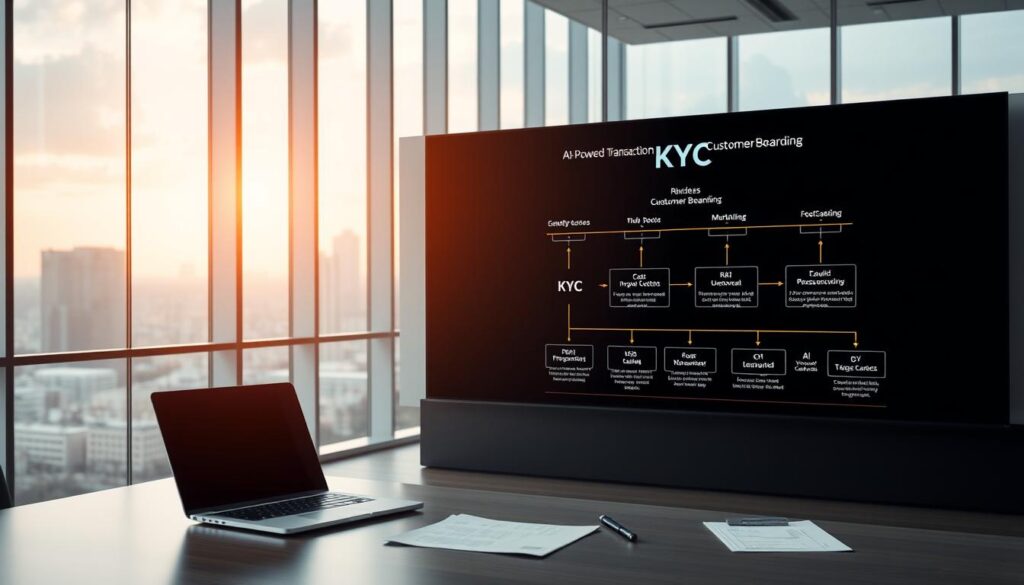Now Reading: Artificial Intelligence Cryptocurrency Regulatory Compliance Explained
- 01
Artificial Intelligence Cryptocurrency Regulatory Compliance Explained
Artificial Intelligence Cryptocurrency Regulatory Compliance Explained

This U.S.-focused guide explains how rules and tools shape today’s digital-asset world. U.S. regulators such as the SEC, CFTC, and FinCEN now push priorities like cybersecurity, market integrity, AML/KYC, and accurate disclosures. The 2024 SEC enforcement actions and spot Bitcoin ETF approvals intensified scrutiny while drawing capital into the market.
Compliance is now strategic: firms must adopt clear controls for custody, the FATF Travel Rule, recordkeeping, and resilience. CFTC oversight on derivatives and qualified custodians for client assets are central duties for exchanges, custodians, DeFi projects, and service providers.
Modern platforms bring real-time regulatory tracking, dynamic risk scoring, continuous monitoring, and explainable workflows. These features turn manual checks into data-driven oversight that scales with growth and keeps audit-ready records.
The goal is practical: lower risk, faster responses to rule changes, better alignment with regulators, and stronger industry credibility. This guide links national rules with global standards and shows how data and analytics prove effective controls.
Key Takeaways
- 2024 enforcement and ETF approvals raised both scrutiny and capital flows in U.S. markets.
- Exchanges, custodians, DeFi projects, and service providers have defined duties under current regulations.
- Real-time platforms enable continuous, explainable oversight and reduce false positives.
- Core operational pillars: AML/KYC, custody, CFTC oversight, recordkeeping, and resilience.
- Data and analytics are essential to demonstrate controls and support supervisory reviews.
- Expected outcomes: lower compliance risk, faster regulatory alignment, and improved credibility.
What this How-To Guide Covers and Who It’s For
This guide translates rulebooks into day-to-day controls that scale with your product and customers. It is written for U.S. businesses planning or running crypto operations and for teams that must show evidence to regulators and auditors.
Expect practical decoding of core requirements: AML/KYC execution, the Travel Rule data exchange, qualified custody and segregation, immutable recordkeeping, cyber policies, and CFTC derivatives oversight.
Primary readers include compliance officers, risk leaders, operations heads, product managers, founders, and legal teams who build or supervise controls.
- How each section builds confidence: mapping rules to controls, workflows, and the evidence auditors and examiners expect.
- How to integrate controls into daily operations without blocking product velocity.
- How to apply a risk-based approach so controls match product scope, customer profile, and volume.
Designed for scaling businesses, the guide stresses sustainable governance, clear escalation paths, and partnerships with regulated custodians to reduce operational risk.
Search Intent and How We’ll Answer It
Most teams want fast, practical answers they can use this week. This section explains how to move from rule text to repeatable controls and audit-ready evidence.
What readers want to accomplish right now
Immediate goal: understand current regulatory compliance expectations and convert them into implementable controls.
- Learn a step-by-step approach to AML/KYC, transaction monitoring, custody safeguards, and reporting.
- See how to assess gaps and create a short roadmap that examiners will accept.
How this guide turns regulations into actionable steps
This guide shows how to map rules to control objectives, control activities, and documented procedures. It also explains measurable outcomes you can test.
You will learn to pick systems that centralize data, automate monitoring, and provide explainable decisioning for reviews. Risk is prioritized so teams can reduce false positives and close higher-impact gaps first.
Quick takeaway for businesses: follow the playbook here to convert compliance requirements into evidence, tighten controls, and prepare for examiner questions.
The Regulatory Landscape in the United States at Present
U.S. oversight now blends agency-specific mandates with shared expectations for internal controls and transparent disclosures.
The three core agencies—SEC, CFTC, and FinCEN—have distinct roles but overlapping goals. The SEC targets cybersecurity, accurate disclosures, and market integrity. The CFTC focuses on derivatives registration and anti-manipulation. FinCEN drives AML/KYC and Travel Rule execution.
Recent actions sharpen priorities. 2024 saw multiple SEC enforcement actions. In 2025 Congress and the SEC signaled renewed attention to payment-stablecoins and market conduct.
Global standards matter. FATF’s Travel Rule shapes U.S. AML expectations, while the EU’s MiCA echoes capital, custody, and recordkeeping concerns. Firms must reconcile rules across jurisdictions to lower legal and operational risk.
How to anticipate agency actions
- Monitor rulemaking calendars, speeches, and enforcement releases.
- Document control rationale, test results, and remediation steps.
- Prioritize fixes tied to weak cyber controls, disclosure gaps, or poor surveillance.
| Agency | Primary focus | Examples of enforcement triggers |
|---|---|---|
| SEC | Cyber controls, disclosures, market integrity | Inadequate disclosures, weak cybersecurity |
| CFTC | Derivatives oversight, anti-manipulation | Wash trades, spoofing, poor surveillance |
| FinCEN | AML/KYC, Travel Rule | Broken KYC, failed transaction-data sharing |
Core Compliance Pillars Crypto Firms Must Operationalize
Operational controls turn high-level rules into daily tasks that teams can run, test, and document. Design each control so it produces clear evidence for audits and examiner reviews.
AML/KYC and the FATF Travel Rule in practice
Translate your AML program into operations: identity checks, sanctions screening, Travel Rule data exchange, mixer-related reporting, and SAR decisioning. Keep simple workflows that link KYC profiles to ongoing monitoring and escalation paths for elevated laundering risk.
Custody and safeguarding
Select qualified custodians, segregate client assets, and show daily reconciliations. Prepare for surprise exams and audits by documenting segregation, proof-of-reserves, and multi-signature workflows.
Derivatives and market conduct
Implement surveillance for wash trading and spoofing, ensure trade reporting accuracy, and build governance around listings and margin rules to meet CFTC expectations.
Recordkeeping and audit readiness
Retain immutable logs that tie on-chain events to off-chain records and financial statements. Assemble examiner packages with control matrices, policy attestations, and exception logs for fast review.
Operational resilience and cybersecurity
Cover key management, incident response drills, and vendor risk reviews. Integrate these controls into enterprise systems and monitoring so reporting is timely and testable.

DeFi’s Unique Compliance Challenges and Practical Paths Forward
DeFi’s open design creates unusual gaps in control and legal accountability that teams must address. Smart contracts and dispersed governance often leave no single party to attest to KYC, AML, or incident handling. That gap complicates enforcement when hacks, fraud, or laundering occur.
Smart contracts, dispersed governance, and accountability gaps
Code-driven rules shift responsibility from firms to communities. That makes it hard to produce audit-ready attestations or assign remediation duties after an exploit.
Self-regulation, decentralized identity, and blockchain analytics
Practical measures help. Community-approved standards, mandatory code reviews, public incident disclosures, and baseline security benchmarks raise the bar.
- Decentralized identity (DID) can prove eligibility without exposing full identity details.
- Blockchain analytics illuminate cross-protocol flows to flag fraud and laundered funds.
Balancing decentralization with transparent oversight
Design teams must weigh risk against openness. Platforms can keep permissionless access while adding oversight where law requires it.
Example policies include code freeze windows, formal change management, bug bounties, and independent audits to reduce exploitation risk.
| Challenge | Practical path | Expected outcome |
|---|---|---|
| Accountability gaps from dispersed governance | On-chain governance logs, multisig timelocks, documented maintainer roles | Clearer audit trails and faster incident response |
| Anonymous onboarding vs. legal checks | DID proofs, risk-based off-chain checks, layered access tiers | Privacy-preserving eligibility with legal defensibility |
| Cross-protocol laundering and fraud | Integrated blockchain analytics and shared indicators | Faster detection and reduced enforcement exposure |
Proactive engagement with regulators helps shape proportionate standards. When platforms show standards and systems that lower risk, institutions are more likely to participate and enforcement uncertainty decreases.
How AI Transforms Crypto Compliance Workflows
Teams are shifting from periodic spot checks to systems that monitor behavior continuously. This change cuts manual sampling and spreadsheet work. It also speeds detection and reduces human error.

From manual review to automated monitoring and documentation
Automated tools replace batch reviews with continuous review cycles. They log every decision and build audit-ready documentation on the fly.
Real-time regulatory tracking and dynamic risk scoring
Modern platforms ingest rule updates and map them to policies. Dynamic risk scores combine behavior, geography, and history to prioritize cases.
Automated decisioning with audit trails and explainability
Configurable thresholds let systems pause or escalate actions automatically. Each action records a rationale so examiners can trace decisions.
- Faster detection and broader coverage than manual sampling.
- Unified alerts, cases, and evidence shorten investigation cycles.
- Human-in-the-loop reviews and model audits preserve explainability and governance.
Result: lower operational burden, clearer reporting, and teams focused on complex analysis and regulator engagement.
Artificial intelligence cryptocurrency regulatory compliance
Modern compliance stacks turn rulebooks into live workflows that act across onboarding, wallets, and reporting systems.
In practice, this means using models and rule engines to align crypto operations with compliance across customer onboarding, sanctions screening, monitoring, and reporting.
Systems map written rules and standards to control logic. That reduces manual interpretation and creates consistent enforcement across teams and products.
Data pipelines link wallets, exchanges, custodians, and case-management systems. These streams supply real-time visibility and build audit-ready evidence for examiners.
- Oversight improvements: role-based access, immutable activity logs, and exception management that strengthen governance.
- Explainability: each automated action stores a documented rationale to meet examiner expectations and lower dispute risk.
- High-value uses: scalable screening, anomaly detection, and rapid policy updates without heavy code rewrites.
Limitations remain. Human validation, model performance testing, and periodic recalibration are needed to match new typologies and keep accuracy high.
| Capability | What it does | Benefit |
|---|---|---|
| Rule mapping | Converts rules into executable control logic | Consistent enforcement, fewer manual errors |
| Data pipelines | Connects wallets, exchanges, custodians, and cases | Real-time visibility and audit trails |
| Explainable actions | Records rationale and decision paths | Clear evidence for examiners and auditors |
Step-by-Step: Building an AI-Ready AML/KYC Program
Design onboarding so the depth of checks matches customer profile, jurisdiction, and use case. Start by categorizing customers and businesses into low, medium, and high risk. That lets you apply proportionate KYC and aml steps without slowing every applicant.

Design risk-based onboarding for customers and businesses
Define clear criteria for each risk tier: product, geography, transaction size, and business type. Tailor identity checks and verification workflows to those tiers.
Quick wins: use ID capture, PEP/sanctions screening, and adverse-media checks to speed decisions while keeping records.
Integrate sanctions screening and Travel Rule data exchange
Deploy real-time sanctions lists and adverse-media feeds that flag matches for human review. For Travel Rule, validate sender and recipient data, secure transport between VASPs, and record reconciliation outcomes in case systems.
Establish continuous monitoring and case management loops
Implement continuous monitoring that updates customer risk scores and triggers enhanced due diligence for anomalies. Link alerts to a case-management flow with triage, investigation steps, decision criteria, and reporting rules for SARs.
- Governance: map policies to procedures, assign control owners, and log metrics that show operating effectiveness.
- Systems integration: connect onboarding tools, wallets, custodians, and ledger feeds for end-to-end traceability and accurate reporting.
| Program element | Key action | Expected outcome |
|---|---|---|
| Risk-based onboarding | Tier customers; apply proportional KYC depth | Faster onboarding and targeted controls |
| Sanctions & checks | Automated screening + human review | Lower false positives, better audit trails |
| Travel Rule exchange | Data validation, secure transport, reconciliation | Meeting FATF expectations and traceability |
| Monitoring & cases | Continuous scoring, case triage, SAR reporting | Faster detection and documented decisions |
Final note: FinCEN’s guidance on customer ID and mixer reporting means programs must evolve. Use automated tools to reduce errors and keep fast, auditable records that show you meet compliance requirements.
Transaction Monitoring with AI: From Rules to Risk Intelligence
Blending rule sets with anomaly models creates a layered net that catches both known and novel threats. This approach ties deterministic checks to behavior-driven alerts so teams see both repeat patterns and fresh tactics.
Configuring thresholds, typologies, and anomaly detection
Start by encoding known typologies as rules. Add statistical thresholds trained on historical transactions and peer benchmarks.
Then, layer unsupervised or semi-supervised models to surface outliers that rules miss. Calibrate thresholds with investigator feedback and backtesting.
Reducing false positives while preserving coverage
- Use risk-based segmentation and entity resolution to filter low-risk flows.
- Enrich alerts with contextual data so analysts can triage faster.
- Log detection logic, alert history, investigator notes, and final determinations in one audit-ready record.
Integrate payment rails and on-chain streams so monitoring covers custodial and non-custodial flows. Schedule periodic model reviews, backtests, and challenger models to detect drift. Lastly, align monitoring checks with broader anti-fraud controls to avoid gaps or duplicated effort and to meet examiner expectations for clear evidence of effective compliance.
Safeguarding Client Assets and Proving It
Proving asset safety requires technical controls, routine reconciliation, and visible audit trails. Build defenses that examiners can test and auditors can verify.
Asset segregation, qualified custody, and proof-of-reserves
Use qualified custodians for client holdings and keep custodial and house wallets separate. Daily balance verification and periodic proof-of-reserves provide transparent evidence of solvency.
Policy-based workflows, multi-sig, and access controls
Policy-based workflows enforce withdrawal approvals and thresholds. Multi-signature setups and hardware security modules reduce single points of failure.
Strict access control lists and logged actions create immutable records for oversight and audits.
- Reconciliation reports tie wallet inventories to ledgers.
- Access logs and approval chains support reporting and examiner reviews.
- Consider regulated services (for example, BitGo) to gain SOC2 Type 2 attestations and insured cold storage.
| Control area | Key action | Evidence for auditors |
|---|---|---|
| Custody | Qualified third-party custody, segregation | Custody agreements, SOC reports, reconciliations |
| Operational controls | Policy workflows, withdrawal approvals | Approval logs, threshold rules, case records |
| Keys & access | Multi-sig, HSMs, ACLs | Key rotation logs, access reports, MFA records |
Incident readiness matters: run penetration tests, vendor risk reviews, and playbook drills so audits show written and tested controls.
Smart Contract and DeFi Risk Controls You Can Implement Today
Reducing protocol fragility starts with clear audit plans and disciplined change processes. DeFi platforms must pair code-level assurance with documented operations so partners and users can trust outcomes.
Independent audits and formal verification
Build an audit program that mandates third-party reviews covering business logic, threat models, and upgrade paths. Use independent firms for at least one full review before mainnet launch.
Formal verification helps for high-value modules. Apply it where assets or governance are systemically important, while noting its limits for complex, evolving protocols.
Change management and emergency controls
Standardize proposals, peer review, staged testing, and scheduled deployment windows. Add emergency pause procedures with predefined roles and an on-call rota to speed safe responses.
On-chain analytics, monitoring, and data retention
Use analytics to map cross-protocol dependencies, liquidity links, and abnormal flows. Feed dashboards and alerting systems into incident playbooks for faster containment.
Capture and retain transaction traces, governance votes, and upgrade artifacts so investigations preserve evidence across decentralized operations.
- Lay out an audit scope that includes security assumptions, invariants, and upgrade mechanics.
- Apply formal verification to core modules and complement with fuzzing and manual review.
- Document controls and ops steps to show institutional partners your compliance posture.
| Focus | Action | Benefit |
|---|---|---|
| Audits | Third-party reviews + scope checklist | Fewer logic flaws and clearer remediation |
| Verification | Formal proofs for high-value code | Reduced systemic risk |
| Monitoring | Dashboards, alerts, retained traces | Faster detection and evidence for investigations |
Data Privacy, Security, and Cross-Border Compliance Considerations
Managing user privacy alongside transaction monitoring demands targeted design choices and governance. Public ledger transparency can expose sensitive data, so teams must balance visibility with protection.

Align privacy and AML needs: use pseudonymization, selective disclosure, and data minimization so monitoring keeps useful traces without overexposing personal details. Map lawful bases per jurisdiction and document why each processing activity is necessary for regulatory compliance.
Secure architectures: adopt zero-trust controls, identity-aware access, and continuous authentication. Harden key management and encrypt data at rest and in transit to raise security across systems and reduce breach risk.
Incident playbook: define detection, containment, forensic steps, notification, and remediation. Involve a DPO, run privacy impact assessments, and build governance for high-risk projects to ensure proper oversight.
| Area | Recommended action | Outcome |
|---|---|---|
| Retention | Minimal retention schedules aligned to BSA reporting | Meet AML needs while limiting stored data |
| Cross-border | Standard contractual clauses + vendor due diligence | Lawful transfers across jurisdictions |
| Governance | DPO reviews + PIA | Documented oversight and reduced risk |
Selecting AI Compliance Platforms and Regulated Custody Partners
Pick platforms that tie onboarding, monitoring, and custody into a single, auditable workflow. Choose solutions that give global KYC/KYB/AML coverage, low-code rule authoring, and real-time monitoring. These features speed investigations and create consistent evidence for examiners.
Integration matters. Look for platforms with clean APIs that connect onboarding tools, CRMs, case-management systems, and custodians so data flows end-to-end. Policy-based workflows and role-based access should map directly to your internal controls.
Vendor diligence essentials
- Verify SOC reports, penetration-test results, and uptime SLAs.
- Check insurance levels, covered perils, and claims history for institutional readiness.
- Ask for resilience testing, incident timelines, and financial strength evidence.
| Selection area | What to verify | Expected outcome |
|---|---|---|
| Platform features | Global data coverage, low-code rules, audit trails | Faster deployment and repeatable evidence |
| Integrations | API connectors to CRM, wallets, custodians | End-to-end traceability of alerts and cases |
| Vendor assurances | SOC2/SOC3, pen tests, insurance, SLAs | Reduced third-party risk and clear audits |
| Controls alignment | RBAC, segregation of duties, approval workflows | Traceable mapping from standards to controls |
Quick checklist for companies: confirm platform features, integration paths, audit attestations, insurance terms, and how each vendor maps to your controls and standards. That makes vendor selection objective and audit-ready.
Implementing AI Compliance: Roadmap, Governance, and Change Management
Start with a practical rollout that breaks work into short sprints. This reduces disruption and creates visible progress for teams and examiners.
Timeline planning, data readiness, and legacy integration
Plan phases: assessment, design, integration, testing, training, and cutover. Typical timelines run 4–12 weeks depending on data quality and connector work.
Data readiness means cleansing, schema mapping, and lineage so alerts and reporting are defensible.
For legacy systems, use adapters and staged syncs to avoid outages while enabling real-time feeds.
Human oversight and model auditability
Human-in-the-loop must review high-risk decisions. That reduces bias and prevents over-reliance on automation.
Schedule periodic model audits, backtests, and explainability checks to validate performance and fairness.
Clear roles, permissions, and escalation protocols
Formalize RACI for owners, approvers, and operators. Map change control for rules and document exception handling.
Enforce least-privilege roles and segregation of duties across operations to limit access risk.
| Area | Action | Outcome |
|---|---|---|
| Roadmap | 6–12 week phased sprints with milestones | Faster delivery, measurable progress |
| Data | Cleansing, schema mapping, lineage | Defensible alerts and accurate reporting |
| Governance | RACI, change control, model audits | Clear ownership and audit-ready records |
| Access & Escalation | Least-privilege roles and escalation paths | Faster incident response and reduced operations risk |
Key risks include biased training data, explainability gaps, and reliance on automation. Mitigations are human review, documented audits, and alignment with applicable privacy and BSA/AML rules.
Staying Ahead: Monitoring, Reporting, and Collaboration with Regulators
Continuous testing and transparent logs help firms turn obligations into demonstrable practice. Forward-looking teams build repeatable checks that run across products and jurisdictions so oversight is consistent.
Continuous controls testing, audit trails, and reporting cadence
Establish a monitoring program that validates controls across business lines. Schedule automated tests, manual spot checks, and quarterly control reviews.
Keep audit trails that capture rule, test outcome, investigator notes, and remediation steps. Align your reporting cadence with board reviews and external commitments so internal governance and external reporting sync.
Participating in rulemaking and industry standards efforts
Engage with regulators through comment letters and supervisory dialogues to clarify expectations early. Join standards bodies to promote interoperable Travel Rule and custody approaches.
- Document all actions taken in response to new guidance or enforcement trends.
- Share lessons with peers to harmonize controls across jurisdictions and reduce fragmentation.
- These practices improve operations, strengthen credibility, and lower enforcement risk over time.
For practical guidance on AML and related processes, see crypto and AML guidance.
Putting It All Together: A Practical Playbook for U.S. Crypto Firms Now
Close the loop with a compact roadmap that sequences high-impact controls and measurable KPIs. Assess gaps, prioritize AML/KYC, custody, monitoring, and reporting, then deliver in short sprints so operations stay nimble.
Set clear governance across companies, organizations, and firms. Assign owners, map escalation paths, and use regulated services and modern platforms to cut manual checks and speed audits.
Track exposure and risk with dashboards for alert quality, backlog, remediation timelines, and capital impact. Startups can scale from minimal viable controls to mature frameworks without overengineering.
Immediate next steps: pick partners, finalize rules and procedures, train teams, and schedule independent reviews against enforcement trends.














